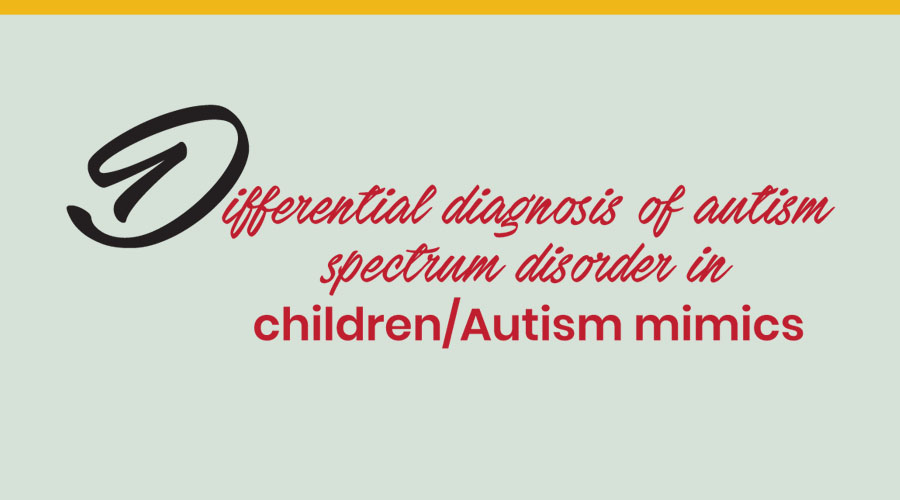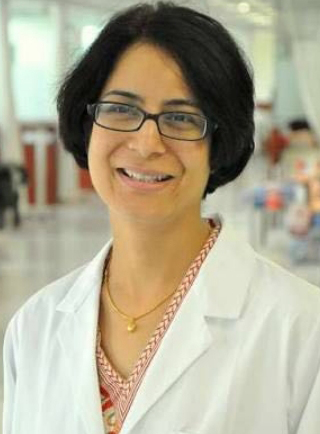Differential diagnosis of autism spectrum disorder in children / Autism mimics
By: Dr. Puja Kapoor
Autism spectrum disorder (ASD) is a neurodevelopmental disorder withpersistent deficits in social, communication and interaction, along with restrictive,and repetitive patterns of behaviour or activities. The clinical features include inconsistent responsiveness specially to name call, extremes of temperament and behaviour, ranging from marked irritability to alarming passivity, delayed or regression of speech and language milestones, repetitive movements, intense interest in a limited number of things and no interest in others.There are yet no blood tests or other diagnostic tests for the confirmation of thedisorder.It is diagnosed as per the Diagnostic and Statistical Manual of Mental disorders- fifth edition, based on clinical observation. There is an overlap of features between ASD and other neurological diseases and disorder. A child needs to be evaluated by a multidisciplinary team inclusive of pediatric neurologist to differentiate ASD from other autism mimics as the treatment and genetic prognostication depends on the etiology of the symptoms.
Differential diagnosis of autism spectrum disorder in children includes:
- Genetic disorders
There are multiple syndromes which overlap the symptoms of ASD along with their characteristic features. A few of the common one are:
- DiGeorge / Velocardiofacial / 22q11.2 deletion syndrome: It is characterized by absence or underdevelopment of the thymus resulting in very low T cell count. Absence or underdevelopment of thymus results in an increased viral,fungal, and bacterial infection. This disorder has been associated with congenital heart disease, cleft palate,hypocalcaemia,immune difficulties, learningdisability, The child shows behaviour similar to ASD. The diagnosis is based on characteristic symptoms, family history and thorough clinical evaluation.Flow cytometry of the peripheral blood and FISH (genetic testing) is used to diagnose the syndrome. The treatment is symptomatic and involves multidisciplinary approach.
- Rett Syndrome: It is a rare non inherited genetic postnatal neurological condition which occurs primarily in girls and rarely in boys.It begins between 6 to 18 months of age. The infant begins to lose eye contact and shows reduced interest in toys, deceleration of head growth (acquired microcephaly) and hand wringing may occur.At 1 to 4 years, the child losses purposeful hand skills and spoken language. Characteristic hand movements such as wringing,clapping, tapping begins during this age.Affected children also develop typical breathing irregularities, feeding and swallowing difficulties, growth retardation, and seizures.Rett syndrome occurs due to mutation in the MECP2 gene on the X chromosome.There is no curative treatment. Supportive management requires multidisciplinary approach.
- Fragile X Syndrome: Fragile X syndrome is the name given to the condition in which affected individuals have a X chromosome which looks “broken” or is “fragile”, and is held together by the slightest of ties.It is characterized by moderate intellectual disability in affected males and mild intellectual disability in affected females. It is a genetic condition with physical features like long and narrow face, large ears, large testicles,flexible fingers,hypotonia.These features are variable may not be obvious till puberty. Other symptoms include flat foot, frequent ear infections,dental problems, heart problems including mitral valve prolapse. One third of them have features of autismspectrum disorder like poor eye contact, hand flapping, language delay. Hyperactivity is common. It is caused by mutation in the FMR1 gene located on the X chromosome at Xq27.3. Normal FMR1 gene have approximately 5-44 CGG repeats and this number remains stable from generation to generation. In the mutated gene, the number of CGG repeats increase more than 200. It causes abnormal methylation and so inability to produce FMRP, a protein made by FMR1 gene, needed for normal development. Diagnosis is by genetic testing, to determine the number of CGG repeats.Treatment include therapies,special education, speech therapy, occupational therapy, behaviour modification program. Genetic counselling is recommended for affected individuals and their families.
- Hearing loss/ Vision loss :Children who have hearing loss may show features resembling autism spectrum disorder. But it could be differentiated by
- The child uses his eyes to watch people.
- Speech and language is affected, but communication is through gestures and pointing is present.
- Visual, auditory stereotypies may be present but they like touch, hugging as opposed to children with ASD.
To complicate the matter, many children may have both hearing loss and ASD simultaneously.So, hearing assessment must be done in any child suspected to have features of ASD.
Motor stereotypies like hand flapping, hand writhing may be present in children with vision loss. These movements along with lack of social and communication skills mimics ASD, and therefore visual examination is must in a case diagnosed with ASD.
- Intellectual disability (ID): An estimated one third of the children with autism have intellectual disability (IQ <70). Intellectual disability needs to be differentiated from ASD, as ID has multiple etiologies and the treatment approach is dependent on the cause. Social communication deficits that define ASD represent a failure to acquire developmentally expected skills, these same deficits would be expected to occur to some extend in all individuals of ID. There is a blurred diagnostic boundary between ID and ASD based on the similarity of the clinical features. It is important to differentiate between the two as ID could have different treatment modality, prognostication and genetic implications based on the etiology.
- Landau Kleffner Syndrome (LKS) : It is a rare childhood disorder characterized by loss of language comprehension (auditory verbal agnosia) and verbal expression (aphasia) in association with severely abnormal electroencephalographic (EEG) finding during sleep, and clinical seizures. The symptoms begin between 2 to 8 years of age. Affected children appear to have acquired deafness as they fail to respond to verbal language and nonverbalsounds. It is one of the common causes of acquired speech loss associated with seizures. Seventy percent of them have frank seizures, most often focal with or without alteration of awareness and/or atypical absence in type.Few children develop hyperactivity, temper tantrums, severe behavioural dysfunction.Diagnosis is by electroencephalogram (EEG) which shows presence of epileptiform discharges.MRI brain is recommended to rule out structural or space occupying lesions. Treatment includes antiepileptic medications. Some may require steroids, IVIG , ketogenic diet.A multidisciplinary approach is required to re-establish communication skills, speech and language concerns.
- Mucopolysaccharidosis type III (MPS III): It is also known as Sanfilippo syndrome. It is a progressive disorder that primarily affects the brain and spinal cord.It do not display any features at birth, but begin to show signs and symptoms during early childhood. Affectedchildren show delayed speech and behaviour problems. They become destructive, restless, aggressive and show difficulty in social interactions and communications. Sleep disturbance is also common in MPS III. This condition later causes progressive intellectual disability and loss of previously acquired skills (developmental regression). They may develop seizures and movement disorders.The children typically have mildly “coarse” facial features, a large head (macrocephaly), a slightly enlarged liver (mild hepatomegaly), umbilical hernias or inguinal hernias. Some children may show short stature, joint stiffness, multiple skeletal abnormalities. They may also have chronic diarrhea, recurrent upper respiratory tract infection and ear infection. Some may also experience hearing loss and vision concerns.It is inherited as an autosomal recessive condition. To diagnose MPS III, mucopolysaccharides (GAGs) are measured in urine,followed by measurement of enzyme activity in blood or skin sample. Genetic testing of a blood sample will allow identification of exact changes in the DNA. Treatment of Sanfilippo is symptomatic and supportive. It has to be managed by a team ofspecialists, to give these children best quality of life.
- Cerebral creatine deficiency syndrome :CCDS are a group of inborn errors of creatine metabolism which interrupt the formation or transportation of creatine. Creatine is important to produce adenosine triphosphate (ATP), which provides energy to all cells in the body.Creatine is essential to sustain the high energy levels needed for muscle and brain development.
Clinical features include global development delay, severe speech delay and is present in all older children and adults. Intellectual disability is of variable severity. Additional symptoms may include seizure disorder, autism like behavior, muscle weakness, and failure to thrive.Diagnosis is by brain MRI with spectroscopy (which shows low to absent creatine peak) and genetic testing.Treatment vary with each CCDSchild.
Oral supplementation by creatine monohydrate is given to replenish creatine levels in the brain and other tissues.A low arginine/protein diet, L-ornithine supplementation, sodium benzoate is used in some children.
It should be considered in all children with autism like behaviour, with seizures, with severe speech delay, positivefamily history of such features. As it can be transmitted as X linked, autosomal recessive (having a 25% chance of recurrence), all children with such clinical features should be screened for CCDS.
- Mitochondrial disease: A significant proportion of children with symptoms of ASD maybe due to mitochondrial dysfunction. Whether autism may involve, or be a result of, systemic physiological abnormalities in the mitochondria rather than being a neurodevelopmental disorder is a topic of debate. In 1985, Coleman and Brass hypothesised the initial association between ASD and mitochondrial function.Mitochondria is the site of energy production or “power house “of the cell. It is important in areas of high energy demand such as brain neurons. More studies are needed to confirm the role of malfunctioning mitochondria as a causative agent or the effect of ASD like neurodevelopmental disorder.
As there is an overlap of symptoms between the above stated conditions and ASD, a careful and thorough clinical examination is must before labelling a child with Idiopathic/primary autism. The approach, prognostication and genetic implications are different for different conditions, so the above stated condition should be kept in mind and screened in a case of ASD, depending on the clinical features.

